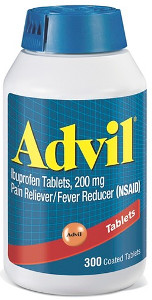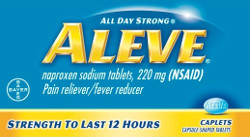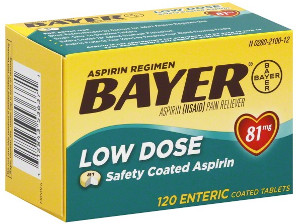Can I Give My Dog Advil, Aleve, or Aspirin?
There are a wide variety of over-the-counter pain medications available to treat minor aches and pains at home. Given the low cost and open availability of such drugs, many owners would prefer to dose their dogs at home rather than put their dogs through a stressful and expensive visit to the veterinarian.
The issue with this course of action is that canine metabolism does not function the same as human metabolism, nor are human medications provided in the correct doses for dogs. A medication that is safe for people is not always safe to administer to your dog.
Each of the popular anti-inflammatory pain medications, (Advil®, Aleve, and Aspirin), varies in potency, but none of them are fully safe for your dog. Given on a short-term or even one-time basis, these non-steroidal anti-inflammatory class drugs (NSAIDs) have the potential to cause serious damage. Always consult with your veterinarian before attempting to give any medication to your dog at home.
Can I Give My Dog Advil® (Ibuprofen)?

Advil®, more commonly known as ibuprofen, is a NSAID produced by Pfizer. Available since 1984, it is one of the most popular over-the-counter pain medications. Currently, there is no trademarked brand of Advil for dogs. It generally comes in the standard formulation of 200 mg pills. Of the three common NSAIDs, Advil® is of moderate potency and has a low margin of safety. It should not be administered at home.
Since the development of safer pain medications for dogs, ibuprofen is rarely prescribed by veterinarians. Prolonged or chronic use of ibuprofen at a therapeutic dose can lead to stomach ulceration and perforation.
Dogs are able to absorb ibuprofen rapidly, and a dose is fully concentrated in the bloodstream within thirty minutes to three hours. Ibuprofen is metabolized by the liver and excreted through the kidneys via urine. It takes dogs roughly four-and-a-half hours to eliminate half of the dose from their bodies (known as the elimination half-life), and ibuprofen is mostly eliminated from the bloodstream in 24 hours.
After a one-time administration of Advil to dogs, signs of irritation or damage to the GI tract are seen at doses as low as 25 milligrams per kilogram (mg/kg). Kidney damage leading to kidney failure starts at 175 mg/kg. Due to the common availability of ibuprofen, extremely large doses have been treated and recorded. Signs affecting the central nervous system (CNS) are seen at doses exceeding 400 mg/kg.
In simpler terms: for every 10 pounds of dog, one-half of a standard 200 mg pill (100 mg) of ibuprofen is enough to cause GI damage, four pills will lead to damage to the kidneys, and nine pills can cause CNS signs.
| Dog's Weight | Pills Taken | Risk |
| 10 lbs | 1/2 Pill | Gastrointestinal Damage |
| 10 lbs | 4 Pills | Kidney Damage |
| 10 lbs | 9 Pills | Central Nervous System Damage |
Signs of Advil® poisoning in dogs include:
- Vomiting
- Diarrhea
- Lack of appetite
- Stomach pain
- Stomach ulceration
- Kidney damage and failure
- Stumbling as if drunk (ataxia)
- Depression
- Coma
- Seizures
- Death
Can I Give My Dog Aleve?

Aleve (naproxen sodium) is a newer drug than ibuprofen, and it was released over-the-counter from Bayer HealthCare in 1994. The human prescription medication is called Naprosyn, but there is no veterinary formula of naproxen for dogs. Naproxen is of very high potency and has a very low margin of safety. It should absolutely not be administered at home to dogs.
Naproxen reaches full concentration in the bloodstream within thirty minutes to three hours of ingestion. Unlike other NSAIDs, naproxen is removed from the body of dogs via bile and stools instead of through the kidneys in urine.
Because of this difference in excretion, naproxen travels through the intestine in bile, giving the drug a chance to be re-absorbed and moved back to the liver. This process, called enterohepatic recirculation, allows naproxen to remain in the body for an extended period of time. The elimination half-life is roughly 74 hours.
One-time administration of naproxen to dogs causes damage and ulceration to the GI tract at 5 mg/kg, and it damages the kidneys at 20 mg/kg.
This means that per ten pounds of body weight, one-eighth of a standard 200 mg naproxen pill will damage the GI tract, and one-half of a pill will lead to kidney damage. In an average 40-pound dog, one naproxen is enough to severely injure the GI tract and nearly enough to cause organ damage. In a smaller 15-pound dog, this dose could quickly be life-threatening.
| Dog's Weight | Pills Taken | Risk |
| 10 lbs | 1/8 Pill | Gastrointestinal Damage |
| 10 lbs | 1/2 Pill | Kidney Damage |
| 15 lbs | 1 Pill | Life-Threatening |
| 40 lbs | 1 Pill | Severe Gastrointestinal Damage + Organ Damage |
Signs of naproxen poisoning in dogs include:
- Vomiting
- Diarrhea
- Lack of appetite
- Stomach pain
- Vomiting blood
- Black, tarry stools (indicative of blood in the feces)
- Weakness
- Pale gums
- Anemia
- Kidney damage and failure
- Death
Can I Give My Dog Aspirin?

Aspirin (acetylsalicylic acid) is one of the oldest pain medications on the market. It was synthesized in 1853, and has undergone many different formulations. Though it is no longer commonly used as a pain medication, it remains medically significant due to its blood thinning properties. While some veterinarians might suggest the use of aspirin at home, prolonged use at a therapeutic level can lead to stomach ulceration. It should not be administered at home without consulting your veterinarian to determine the safety of aspirin with your pet’s health history.
Aspirin is less potent than the other two and has a slightly larger margin of safety.
Aspirin is fully absorbed into the bloodstream between thirty minutes and three hours of administration. Similar to ibuprofen, aspirin is broken down in the liver and is eliminated through the kidneys in the urine. The time it takes to be removed from the body varies based on the drug’s formulation and the amount given. It can exit as quickly as one hour and last as long as 44 hours.
There is a large market for pain meds for dogs, so while aspirin has been used in the past to treat symptoms of pain and discomfort, it is no longer commonplace. There are many brands of aspirin for dogs available online and in pet stores.
Prolonged administration of aspirin at a therapeutic dose can lead to gastrointestinal and mouth damage. Large single doses between 450-500 mg/kg can cause severe problems including kidney and CNS issues, though damage to the digestive tract is seen at lower doses.
For every 10 pounds of body weight, a dog would have to eat about six pills before reaching the amount where the most severe signs occur. So, an average-sized 40-pound dog would need to consume 24 pills in one sitting before there is a great concern for life-threatening issues. But, long-term damage can still happen at lower doses.
Signs of aspirin poisoning in dogs include:
- Vomiting
- Diarrhea
- Stomach ulceration
- Fever
- Panting and heavy breathing
- Coma
- Seizures
- Liver death
- Kidney damage and failure
Why Are Pain Killers Dangerous For Dogs?
While dogs metabolize many drugs differently than humans, much of the problem stems from size. The dangerous dosage of NSAIDs in humans is often very similar to that of dogs. But over-the-counter medications are dosed with humans in mind.
A 170-pound human who gives their 10-pound dog one human dose of medication is considerably overdosing their pet. This would be equivalent to one human taking 17 pills all at once. Pills cannot be split evenly, meaning that you cannot guarantee exactly how much medication is in a piece of a pill, even if you try to cut it in half. When you are dividing one pill by a factor of 17 potential doses, the differences between pill pieces can be extreme.
Many pills are also coated in a thin, sweet film to aid us in swallowing compacted powder. The sweet smell and taste of the coating is appealing to dogs, causing them to be more prone to chewing open bottles of medication to eat multiple pills.
Treatment For Accidental Exposure To Pain Medication
What should you do if you accidentally give an NSAID to your dog, or if your dog chews into an entire bottle?
- Estimate the number of pills your pet swallowed to the best of your ability, rounding up to be on the safe side.
- Make sure you round up all the plastic pieces of the bottle, including the cap. This will help you determine if pieces are missing.
- Check the dose of each individual pill. This is usually stated on the front of the label and given in milligrams (mg).
- Determine the time frame the exposure occurred. Use the earliest possible time you saw the pill bottle intact, or the last time you left the room when everything looked normal. Remember, when you notice something missing is not the same as when it actually went missing.
- Call your veterinarian or an animal poison control center for advice.
- Do not attempt to treat your dog at home without the guidance of a veterinarian. At-home treatments such as inducing vomiting can be extremely dangerous to some pets and even with some specific drugs. Attempting to do this before consulting with a veterinarian in order to avoid a large bill often leads to more serious health problems.
Both the ASPCA Animal Poison Control Center (888-426-4435) and the Pet Poison Helpline (855-764-7661) charge between $60 to $65 per consultation. In some cases, the veterinary toxicologists on staff may be able to guide you through treatment at home in order to avoid the bill for a trip to the animal emergency room. While many medications do require a trip to the veterinarian’s office for treatment, your veterinarian will need to speak with an expert in toxicology to receive information on how to treat a specific formulation of a drug. Calling poison control may be pricey, but it is necessary for appropriate care.
What Types of Treatment Can I Expect At A Clinic?
For most NSAIDs, the treatments for accidental exposure are very similar. You can anticipate that your veterinarian will likely need to do the following things (depending on the overall dose):
- Try to retrieve the pills by inducing vomiting if you are unable to do so at home. This will not be done if your dog is already vomiting or has a history of any medical issues.
- Sometimes your veterinarian will administer activated charcoal to prevent the further absorption of medication. This is not always a safe treatment, so it may or may not be offered.
- Start your dog on stomach protectants to prevent further damage and ulceration to the stomach and intestines.
- Give IV fluids to help flush any medication that was already absorbed out of your dog’s system.
- Take blood to test for organ damage such as damage to the kidneys. This blood work often has to be repeated to ensure that the organs continue to function normally over time.
- Give medications to reverse any severe signs such as seizures, coma, or repeated vomiting.
- Hospitalize your dog to fully monitor their progress and continue to administer treatment until the drug is completely gone from the body.
References & Notes
- Merck Manual Veterinary Manual Toxicities from Human Drugs, Analgesics Toxicity
-
Poppenga, Robert H., and Sharon Gwaltney-Brant, editors. Small Animal Toxicology Essentials. John Wiley & Sons Ltd, 2011.
